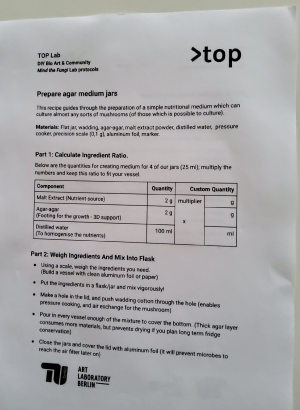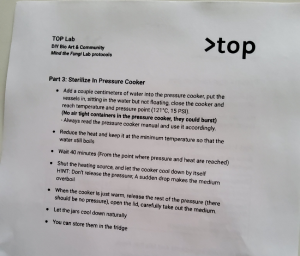| Line 251: | Line 251: | ||
== Making the substrate == | == Making the substrate == | ||
For the substrate we followed this guide. (insert picture) | |||
We decided to make 500ml of the solution so we could have a few tries from the beginning in case some of them failed. Working with live organisms is a lot of trial and error. | |||
For that I first did some calculations and multiplied all the necessary ingredient times five, since the recipe was originally for 100ml of solution. I wrote everything down to make it easier for myself once I actually got to weigh everything with the scales. (insert picture) | |||
I got into the lab equipment which consists of a lab coat, gloves and goggles. I sterilised my hands before and after getting on the gloves, as well as my workspace and all my materials to minimize contaminations that could jeopardize growing the culture of Euglena. | |||
I prepped my workspace with the necessary tools: a highly accurate scale (for the tiny amounts of chemicals you need), the necessary chemicals in order of the recipe, distilled water, a tiny spatula, tin foil as a base to put the chemicals on for weighing, my bottle for the finished solution; sanitizer and papertowels to clean the spatula between going into the different chemicals to prevent crosscontamination of products. | |||
I made the base solution and solution one with the help of Alessandro. Solution 2 and 3 were kindly provided by Miga. | |||
== Ideas for using Euglena == | == Ideas for using Euglena == | ||
Revision as of 18:50, 29 January 2023
Documenation of the main Workshop 04.11.22
Plan for today (04.11) and tomorrow (05.11): -> cultivate first organism (mushroom) -> lab safety (how to work safely in the lab) -> getting to know the lab equipment -> Redesign the lab experience for our own home (How to make our own Diy-Biolab) -> lab ethics and values
Materials and manual for growing first organisms:
Different organisms need different things to grow
examples: -> Algae can photosynthesize; they need light and salt -> slime mold (unicellar organisms that expand in search of food; they're neither fungi nor mushrooms) -> bacteria
- We had a break from 11:45 am to 01:30 pm -
Building a Diy-Lab at home
Resources :
Equipment:
local shopping
-> hardware store (tables with a glass or ceramic top)
-> bricolage market
-> artists shop
-> pharmacies
online shopping
-> amazon; new equipment
-> Ebay; used equipment
-> Aliexpress; quick and cheap
consumables (cottonswabs/gloves etc.)
-> amazon; for small fast delivery
-> aliexpress; for cheap batch delivery
-> alibaba
-> specialised onlineshops; more or less specialised producers and retailers
chemicals
-> Buying at local stores (check cross-application; check purity grade according to use)
-> online shopping (check if law allows private purchase)
-> maybe extract your chemicals from mixtures (know what you are doing and with whom)
Growing our own mushrooms
For the Mycofabrication session we used Reishi (Ganoderma Lucidum)
what do we need?
1. Mushroom/spores where can you find it:
online shops -> Pilzmännchen.de -> MycoGenetics the forest: -> on the ground -> on dead logs or living trees
2. Substrates (mushroom food):
buy at local stores or online -> Bricolage market (saw dust) -> Pet shop -> Carpenter
3. Knowledge
Books:
Mycelium running: how mushrooms can help save the world (2004)
Organic mushroom farming and mycoremediation (2014)
Radical Mycology: A Treatise on Seeing & working with Fungi (2016)
The fifth kingdom; An introduction to mycology Bryce Kendrick (2017)
Academical knowledge
first -> wikipedia and sources (gives good overview; sources; scientific papers)
second -> academic papers (google schola; unpaywall.org; if behind paywall: ask for copy; wikipedia.org/Sci-Hub: grey area of copy right)
"if you have a big goal break it up into small goals you can achieve"
Ethics and values in the lab
-> respect for our creatures
-> respect for lab partners
-> don't take criticism personally
-> only go to the lab when you are healthy and in the right mood (concentrated; healthy; good mindful mindstate)
-> respect time and projects of others (name everything; report when things run out or get broken)
How to respect our creatures and each other:
-> what is the specimen? (mushroom parts still thrive even if you take parts of it for example)
-> destroy things that aren't from here
-> nothing leaves the lab alive unless it comes from the natural habitat outside
-> we work to help understand more for everyone (goal: sustainability)
-> respect experts from other fields (everybody can provide value)
-> be inclusive; everybody is equal
05.11.22 10 am to 2 pm
Plan: Projectdraft
Presentation of some organisms
-> Brainstorming to one organism in groups of 3-4 people (what can we do with it? how can we present that idea?) and create 5 ideas
Creatures:
slime mold: one big cell that grows toeards the food. What experiments can be done with it? Idea: how would slime mold plan rail networks
Euglena (Algae): can photosynthesize and reuse CO2 ; moves slowly towards the light
Mycelium: Idea: modular bricks for building structures
Glow in the dark mushrooms (pomellus stipticus): idea: exitlights/nightlights filled with mushrooms
Combucha (yeast and bacteria living together) creating paperlike structure when dried
One hour to make up 5 ideas -> Why? How? What?
1. Exit signs from glowing mushrooms (brightness?lifetime?)
why? no, electricity but importance of finding the exit how? glowing mushroom jars What? exit signs and emergency paths
2. Animation with Euglena (filming them moving towards the light; making templates that partly block out the light to create pictures etc.)
why? for entertainment how? templates, light, experimentation what? animations, music videos, stop motion animation etc.
3. Lampshade from dried Combucha for interesting light effects
why? warm light and interesting patterns
how? dry the combucha, make patterns for the lampshades
what? lampshades; windowshades
4. plates with slimemold layered to create interesting paintings
why? new technique for artists; new medium
how? slime mold grown on transparent plates, layered behind one another
what? layered paintings
5. Pens made from mycelium
why? less plastic is used how? develop case for pens out of mycelium what? compostable pen cases; maybe Diy Kits for teens
- 20 Minute break -
Group session 2
-> Develop one of our ides further; chosen idea: glowing exit signs
structure:
why?
-> saving electricity
-> sustainability
realisation process
-> grow fungi (panellus stypticus)
-> inside glass cube
-> run some tests on when the mushroom glows
-> setup gives mushroom food and moisture
-> find out more about mushrooms biorythm
Plans for setup
-> reuse old exit-sign cases (test if it works with the plastic and color)
-> fill it with substrate and grow mushroom in there
-> install mushroom case
where do we want to exhibit it? Showcase 3 places here in Weimar
-> University
-> Lichthaus Kino
-> Jena botanischer Garten
Necessary tests:
-> biorythm testing
-> longtime study of mushroom lifespan
-> temperature? Is roomtemperature okay?
-> Nutrition? Is moisture in the substrate?
-> when does it glow? How does it decide to glow? Can it be used during the day?
-> examine exit signs; Are there brightnesslevels that have to be achieved? Is the case a suitable home for the mushroom? Who to ask for permission to install the mushroom cases
Chosen Organism: Euglena
To-Do's
- grow Euglena
- care for Euglena
- work out a creative Projekt using Euglena
Process of growing Euglena:
I met with Alessandro on the 16th of November to start growing Euglena gracilis.
Making the substrate
For the substrate we followed this guide. (insert picture) We decided to make 500ml of the solution so we could have a few tries from the beginning in case some of them failed. Working with live organisms is a lot of trial and error. For that I first did some calculations and multiplied all the necessary ingredient times five, since the recipe was originally for 100ml of solution. I wrote everything down to make it easier for myself once I actually got to weigh everything with the scales. (insert picture) I got into the lab equipment which consists of a lab coat, gloves and goggles. I sterilised my hands before and after getting on the gloves, as well as my workspace and all my materials to minimize contaminations that could jeopardize growing the culture of Euglena. I prepped my workspace with the necessary tools: a highly accurate scale (for the tiny amounts of chemicals you need), the necessary chemicals in order of the recipe, distilled water, a tiny spatula, tin foil as a base to put the chemicals on for weighing, my bottle for the finished solution; sanitizer and papertowels to clean the spatula between going into the different chemicals to prevent crosscontamination of products. I made the base solution and solution one with the help of Alessandro. Solution 2 and 3 were kindly provided by Miga.

